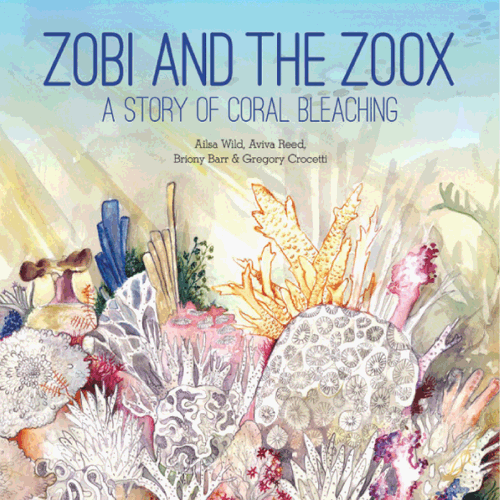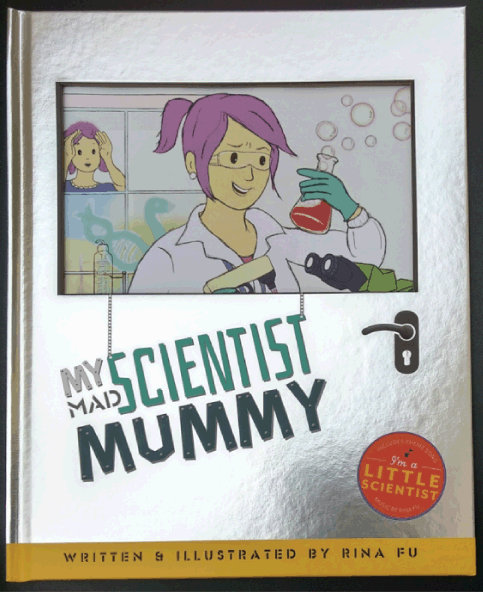Book reviews
Microbiology Australia 39(4) 227-227 https://doi.org/10.1071/MA18053
Published: 17 August 2018
Zobi and the Zoox; A Story of Coral Bleaching
Ailsa Wild, Aviva Reed, Briony Barr and Gregory Crocetti
CSIRO Publishing, 2018

|
It sounds like a great name for a rock and roll band, but it’s a highly educational and quite entertaining story book about the microbial ecology of coral-microbial symbioses and coral bleaching. Zobi (a rhizobium) and the zoox (dinoflagellate zooxanthellae) live symbiotically with a coral polyp named Darian, who is suffering from heat stress. Their problems are explained and illustrated creatively and beautifully in colourful, large artistic drawings of chemical reactions, cellular processes, cells and tissue layers. Zobi and Cy (a cyanobacterium in the coral mucus) watch in horror as Darian expels thousands of zoox from his gastrodermis into the surrounding ocean. The microbial consortium in the mucus starts to die off as slimy green algae invade. Can the rhizobia assist the zoox in time to save Darian and his colony, which is home to them all?
I’ll leave you in suspense, but rest assured the story has a satisfying ending and a good message about threats to coral reefs from climate change. A strong theme throughout the story is biological symbiosis and the value of working together for mutually beneficial goals. Another effective theme is that of spatial scale, emphasising interacting processes within and across molecular, cellular, organismal, reef, and even planetary levels. Much of the exceptional and delightful artwork shows enlargements of microbes or chemical reactions (in blow-up circles akin to a microscope’s field of view) set against the larger context of a coral polyp or a reef community of corals, fish, and sea turtles.
The 28-page story is followed by a 17-page tutorial on ‘The Science Behind the Story’, which explains the biology of the organisms and symbioses, the chemistry of processes like photosynthesis and nitrogen fixation, the microbial ecology of mucous layers, coral reefs and coral bleaching at a quite sophisticated level for young readers, yet in simple language and with additional beautiful artwork and micrographs. Other highlights are the pronunciation guide at the start and the illustrated glossary at the back.
The book serves a variety of audiences and purposes. The story itself would be engaging and educational for older primary school children, while the tutorial would be instructive, enjoyable, and sufficiently challenging for secondary school students. Although, to high school students it might feel too much like a children’s book overall. For professional microbiologists, the book will be fun and helpful to those wanting to promote an understanding of microbial ecology and environmental issues to a young audience, and the book serves as a model of effective science communication to the public. The artwork itself would be pleasing and a great conversation starter on a microbial ecologist’s office wall!
Associate Professor Jeff Shimeta is a marine scientist at School of Science, RMIT University, Melbourne, Australia.
My Mad Scientist Mummy
Rinu Fu
Little Steps Books, 2018

|
My Mad Scientist Mummy is a cool book for kids. It is a great way to tell young children at home and school about the great world of work as a scientist who, by the way, is also a MUM. Dr Madeline Mummy is happily ensconced in her laboratory with her flasks and microscope as a research scientist. She has lots of smiling scientist friends she works with, even some laboratory staff with big rabbit ears and long tails. None of them look mad, but Dr Mummy’s little daughter must have heard whispers about ‘mad scientists’ because she does wonder if her Mummy might be mad. Well, after exciting adventures to the lab, where she is decked out in cool safety gear she watches open mouthed with wide eyes as Mummy’s exciting experiments eventually come to life. All is well – Mummy is not a mad scientist – but – turn the page – she can get mad!
Having had three children myself who struggled to picture my non-mum scientist life, this children’s book, with great illustrations, is a novel idea that should be embraced by young scientist mums everywhere. A good bed-time story for the kids when you come home from work!
Prue Bramwell is a microbiologist and academic at RMIT University.


